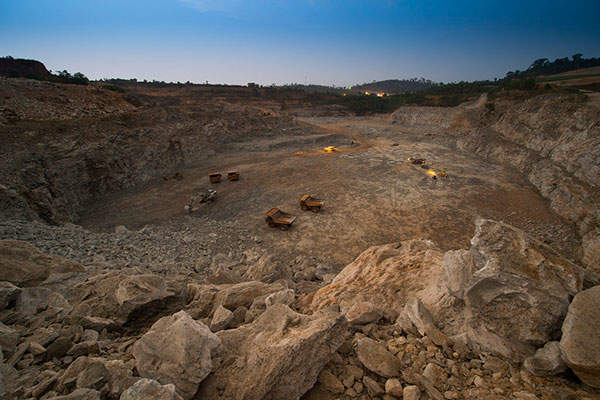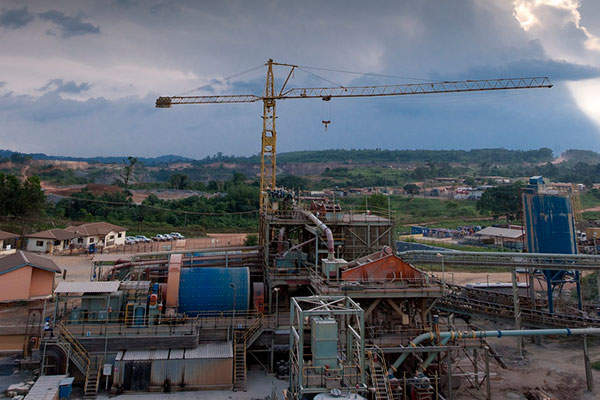Golden Star (Wassa) (GSWL), a subsidiary of Golden Star, owns and operates the Wassa gold mine in south-west Ghana. Golden Star holds a 90% interest in GSWL, while the Ghanaian Government holds the remaining 10% ownership, earning a 5% royalty on the gross revenue of GSWL’s gold production.
Open-pit mining at Wassa started in October 1998 before Golden Star acquired the mine in 2002 in a sale and placed under care and maintenance. Mining at the open pit was resumed from April 2005.
The project was expanded into a high-grade underground mine. Drilling for the expansion started in 2011 and a feasibility study for the underground mine was completed in March 2015.
Construction of the underground mine began in mid-2015 and pre-commercial production started in June 2016. Commercial production from the underground mine was achieved in January 2017. The mine is forecasted to produce an average of 163,000oz of gold a year over its eight-year production life.
Wassa gold mine location, geology and mineralisation
The mine is located on the eastern side of the Ashanti belt, approximately 150km west of the capital of Accra. It is situated within the Ashanti Greenstone Belt and lies on the eastern margin within a volcano-sedimentary assemblage located close to the Tarkwaian basin contact.
The mine consists of a lithological sequence characterised by meta-mafic volcanic and meta-diorite dykes. The deposit is intruded by Eoeburnean felsic porphyry on the south-western side of the mine fold.
Orebodies of the deposit are hosted by a series of interbedded metavolcanic and metasedimentary units. The mineralisation is structurally controlled and made of broadly tabular zones hosting narrow quartz vein material.
Wassa gold mine reserves
As of 31 December 2015, the Wassa open-pit and underground mine was estimated to contain proven and probable mineral reserves of 20.36 million tonne (Mt) at an average grade of 2.27g/t Au. The contained gold is estimated to be 1.48Moz.
Mining and processing of Wassa ore
Conventional truck and shovel mining method, using drilling and blasting, is applied at the open-pit mine. Mining is mostly conducted in the main Wassa pit, along with Benso and Hwini Butre satellite pits, with an average ROM production rate of 2.4Mtpa.
Underground production began in 2016, and will increase over 18 months to an average annual production rate of 785,000t. Mining equipment at the underground operation includes Caterpillar load haul dump trucks, Sandvik jumbos and DL411 drill rigs, CAT AD55 haul trucks, CAT 12H grader, and CAT 966 front-end loader.
The underground mine is accessed through a decline from the starter pit, which is backfilled using cemented rock fill. The decline also acts as the primary ventilation intake for the initial years of operation.
Ore from the open pit is currently processed at a 2.7Mtpa capacity non-refractory processing plant, which employs traditional carbon-in-leach technology.
The processing activity includes crushing, screening and agglomeration of the mined feed material before being placed on heap leach pads and irrigated with a weak cyanide solution to recover the gold. The solution is processed through carbon columns, stripped from the loaded carbon and smelted through to gold doré bars.
Infrastructure facilities at Wassa
Power supply for the mine is provided by the national power supplier GridCo through a 161kV line from a 33MVA ONAF transformer and two onsite feeders.
A new underground transformer and generator yard was constructed and installed with a 5MVA transformer. Power to the underground transformer is supplied by a new dedicated switch/breaker by means of underground cables.
A 30,000l water tank was built for the portal area to supply the underground mine with service water, which is collected either from the starter pit sump or the Dead Man Hill pit sump.
Financing of Wassa gold mine
In July 2013, Golden Star closed a $50m secured medium-term loan facility with Ecobank Ghana, a pan-African full service bank, for developing the Wassa mine.
Wassa also received an additional $25m secured medium-term loan facility from Ecobank Ghana in September 2014.
Gold stream transaction with RGLD Gold
In May 2015, Golden Star entered a $130m gold stream transaction with RGLD Gold, a wholly-owned subsidiary of Royal Gold, to finance the underground development projects at the Wassa and Prestea mines.
As per the transaction, Royal Gold is entitled to receive 8.5% of the gold, subject to a maximum of 185,000oz, produced from Wassa, Bogoso and Prestea mines. A further 5% gold is given until an additional 22,500oz are delivered and 3% thereafter. Royal Gold pays 20% of the spot price until the delivery of 207,500oz and 30% thereafter.
Apart from the transaction, RGI provides a four-year term loan of $20m to Golden Star. Golden Star Resources is expected to issue warrants to purchase five million common stock shares to RGI.






